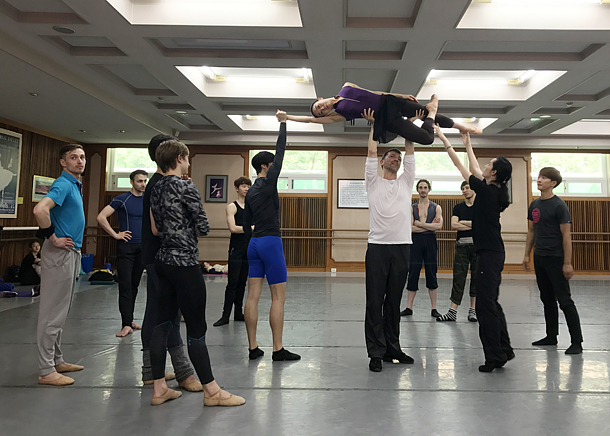Korea’s modern dance pioneers to premiere Raimondo Rebeck’s ‘White Sleep’

Rebeck shows dancers of Universal Ballet Company one of the movements in his new work “White Sleep” which will make its world premiere next week. [YIM SEUNG-HYE]
Believing that bringing quality modern dance and growing ballet audiences is part of their role as a company, UBC decided to participate in the upcoming “Ballet Festival Korea,” which runs from June 8 to 25 at the Seoul Arts Center, southern Seoul, with three different works under the title “This is Modern.”
The performance will include the world premiere of a new piece from German choreographer Raimondo Rebeck - a 17-minute piece titled “White Sleep.”
Although his name may not be a as well known as Kylian or Naharin, UBC said Rebeck’s creation is a high-quality piece that it can be packaged together with the legends. When the Korea JoongAng Daily visited the Universal Art Center on Monday, Rebeck was meeting with the some 20 dancers who will perform his piece and discuss how to better execute a specific movement. After the rehearsal, Rebeck sat for an interview. The following are edited excerpts.

Raimondo Rebeck [UBC]
A. Maybe the words dementia or Alzheimer’s are too much but “White Sleep” is inspired by this disease. For 17 minutes, I am trying to touch on the idea of things that you forget slowly in life. My grandmother, who meant the most to me, suffered from the disease, so I saw how things slowly disappeared from the mind. I think with memories, there are two opinions. Sometimes, it is harder to forget than to remember but also sometimes it is harder to remember than to forget. So what I’m trying to do is to play with this. It’s not dramatically bad to forget. I talked to those who suffer from dementia, including my grandmother, and found out that it’s hard when they can’t remember things in the beginning but then they cross a line where it doesn’t bother them anymore and it’s not so bad for them to forget. It’s like they forgot how to forget. If you forgot everything, you cannot forget anything. I saw this as a positive thing. If your mind starts to forget things and it becomes empty, one can see it as a total darkness or pure white. I saw it as white and named the piece “White Sleep.”
You selected music from the composer Philip Glass. Why?
In Europe, Philip Glass is very popular. I think his music is perfect for dance. Musicians may find it too minimal, but for dance, it gives you the right flow and when you listen to his music, as a choreographer, you start to paint pictures of the movements.
How you do feel about your work going to the Eurasian Dance Festival in Kazakhstan soon after the upcoming premiere here?
I am very honored. It’s a new piece and after the premiere here having somewhere to go immediately is such an honor. And the fact that it will be performed together in a package, sandwiched between Kylian and Naharin’s pieces, who are my idols, I am so grateful for the trust and the chance from the artistic director here at UBC that she gave me to put my piece between these two choreographers.
How would you define your style of choreography?
Organic. I’m not in the mood to discover always new movements. It’s more of just bringing the movements we have already together to create a story. We have millions of steps and I’m trying to bring it together in an organic way. It’s like writing. You have millions of words already so you don’t have to invent new words to write a story.
BY YIM SEUNG-HYE [sharon@joongang.co.kr]










with the Korea JoongAng Daily
To write comments, please log in to one of the accounts.
Standards Board Policy (0/250자)